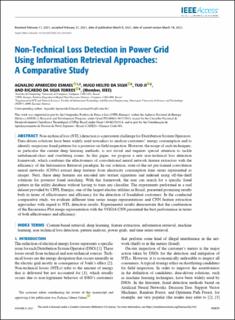| dc.contributor.author | Esmael, Agnaldo | |
| dc.contributor.author | Silva, Hugo | |
| dc.contributor.author | Ji, Tuo | |
| dc.contributor.author | Torres, Ricardo Da Silva | |
| dc.date.accessioned | 2021-03-18T06:53:07Z | |
| dc.date.available | 2021-03-18T06:53:07Z | |
| dc.date.created | 2021-03-17T16:45:54Z | |
| dc.date.issued | 2021 | |
| dc.identifier.citation | IEEE Access. 2021, 9, 40635-40648. | en_US |
| dc.identifier.issn | 2169-3536 | |
| dc.identifier.uri | https://hdl.handle.net/11250/2734027 | |
| dc.description.abstract | Non-technical loss (NTL) detection is a persistent challenge for Distribution System Operators. Data-driven solutions have been widely used nowadays to analyze customers’ energy consumption and to identify suspicious fraud patterns for a posterior on-field inspection. However, the usage of such techniques, in particular the current deep learning methods, is not trivial and requires special attention to tackle imbalanced-class and overfitting issues. In this paper, we propose a new non-technical loss detection framework, which combines the effectiveness of convolutional neural network feature extractors with the efficiency of the Information Retrieval paradigm. In our solution, state-of-the-art pre-trained convolution neural networks (CNNs) extract deep features from electricity consumption time series represented as images. Next, these deep features are encoded into textual signatures and indexed using off-the-shelf solutions for posterior fraud searching. With this framework, the user can search for a specific fraud pattern in the utility database without having to train any classifier. The experiments performed in a real dataset provided by CPFL Energia, one of the largest electric utilities in Brazil, presented promising results both in terms of effectiveness and efficiency for the detection of fraudulent customers. In the conducted comparative study, we evaluate different time series image representations and CNN feature extraction approaches with regard to NTL detection results. Experimental results demonstrate that the combination of the Recurrence Plot image representation with the VGG16 CNN presented the best performance in terms of both effectiveness and efficiency. | en_US |
| dc.language.iso | eng | en_US |
| dc.publisher | Institute of Electrical and Electronics Engineers (IEEE) | en_US |
| dc.rights | Navngivelse 4.0 Internasjonal | * |
| dc.rights.uri | http://creativecommons.org/licenses/by/4.0/deed.no | * |
| dc.title | Non-technical Loss Detection in Power Grid Using Information Retrieval approaches: A Comparative Study | en_US |
| dc.type | Peer reviewed | en_US |
| dc.type | Journal article | en_US |
| dc.description.version | publishedVersion | en_US |
| dc.source.pagenumber | 40635-40648 | en_US |
| dc.source.volume | 9 | en_US |
| dc.source.journal | IEEE Access | en_US |
| dc.identifier.doi | 10.1109/ACCESS.2021.3064858 | |
| dc.identifier.cristin | 1898822 | |
| dc.description.localcode | Open Access CC-BY 4.0 | en_US |
| cristin.ispublished | true | |
| cristin.fulltext | original | |
| cristin.qualitycode | 1 | |

